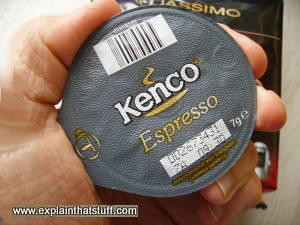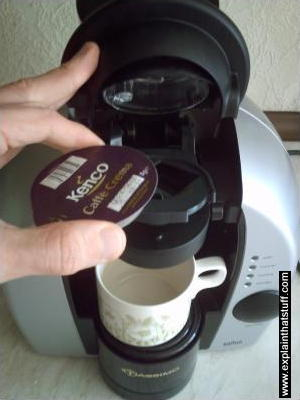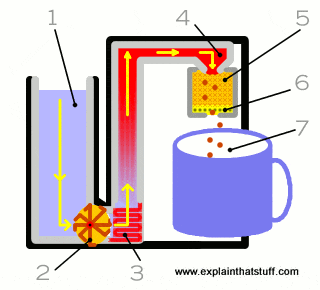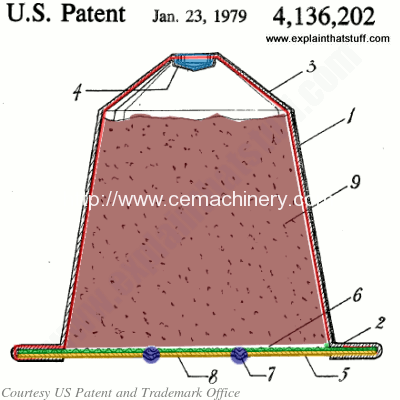Single-serve “pod” coffee makers
If you love a good cup of coffee but you can’t be bothered with all the fuss of grinding beans, spooning out ground coffee, or boiling a kettle, apod-coffee maker could be just the thing you’re looking for. These truly idiot-proof machines pack all the mess and fuss into a simple, disposal plastic pod—as easy and convenient as a tea-bag—and they can deliver excellent quality coffee in a couple of minutes. Although they’re quite expensive, they can quickly pay for themselves if you’re in the habit of buying your drinks at the local coffee shop. Let’s take a closer look at how they work!
Photo: Left: A typical pod coffee maker: the Braun Tassimo™ coffee pod machine. Rival machines are sold under Nespresso™ and Senseo™ brands. On this machine, the water tank is at the back, under the circular black lid. The pod fits into the silver compartment at the front, on top. Once you’ve load up the water and the pod, you press the large black button on the bottom right to deliver your coffee. That’s all you have to do: fill up with water, insert your pod, and press the button. Nothing could be simpler!
Table of Contents
How to make a perfect cup of coffee
However you choose to make your coffee, you’ll know there are two essential ingredients: water and the coffee itself. To make perfect coffee, the water must not be boiling hot: it needs to be slightly cooler, at a temperature of about 88–96°C (190–205°F); the exact temperature depends on the type of coffee you’re using. As for the coffee, as most people surely know, coffee comes off the tree in the form of beans, which have to be processed in various ways, then roasted (cooked) and ground to a powder to release the flavor we all love.
A typical Kenco coffee pod made for the Tassimo machine. There’s a selection of coffees for most of the pod coffee makers, but the choice is much more limited than if you were buying ground coffee or beans. Pods made for one machine will generally work only in that machine.
Making coffee with the Braun Tassimo. You take a pod (t-disc) like this one, loaded up with ground coffee, and insert it into the machine. The machine reads the barcode on the top and figures out exactly what to do. Different coffee pods will make the machine behave in different ways, pausing longer before they start forcing the water through, using different amounts of water, or whatever. The point is that the machine does all that for you. All you have to do is press a single button to deliver a great cup of coffee in a minute or two.
To turn ground coffee into drinkable coffee, you put the water and the coffee together—but different coffee-making techniques do this in different ways:
Cafetière (French press): You simply spoon water into the pot and pour hot water over it. The water slowly releases the flavor from the coffee grounds, as convection currents swirl them around. It takes about 5 minutes to make a decent pot.
Filter coffee: You put the coffee inside filter paper and pour boiling water over it. A “pour-over” as this is sometimes known, can make excellent coffee, but it’s also a bit of a fiddle and it can be messy.
Percolator: Hot water is endlessly bubbled through a metal coffee container at the top of the machine to make very strong coffee. The trouble here is that you have to clean out the percolator and its mechanism when you’re done.
Instant coffee: The easiest coffee of all! You put a spoon of coffee powder (containing concentrated coffee essence) into the bottom of your cup and pour near-boiling water over to make it dissolve. There’s nothing to clean beside your cup, but the coffee usually tastes diabolical.
Coffee-shop machine: The espresso machines you see in coffee shops usually make the best coffee. They work by heating water quickly to the perfect temperature, before forcing it at high pressure through a metal vessel containing ground coffee. But professional machines are expensive and it takes great skill to use one properly. They’re also a pain to clean.
So… lots of coffee-making methods but ultimately one simple choice: you can either have quick-and-easy, bad-tasting coffee or you can have decent coffee but suffer the time and trouble of making it. In the last few years, however, ingenious coffee companies have hit on a way to let us enjoy coffee-shop quality at instant-coffee speed: the coffee pod machine.
From K-Cup® and Tassimo™ to Nespresso™, Senseo™, and Dolce-Gusto™, there are quite a lot of different pod machines available. Even so, the basic principle is pretty much the same in each case. You start off with a pod (ground coffee inside a plastic container lined with filter paper and sealed with foil) and place it inside your machine, which breaks through the foil automatically. The machine heats the water to almost boiling (probably about 90°C or 190°F or so), then forces it at high pressure through the coffee in the pod into your cup, in a similar way to a traditional espresso machine. Machines such as the Tassimo have separate coffee and milk pods (typically containing UHT milk), although you can always leave out the milk pod and add your own fresh milk (or frothed milk, if you’re making a cappuccino) later.
How coffee pod machines work
Greatly simplified, this is what happens inside a typical pod machine:
- You load water into the tank at the back.
- A pump at the bottom sucks the water in and pumps it through the machine.
- The water heats up to the perfect temperature as it flows up past theheating element.
- The water is pumped through a narrow needle to increase its pressure.
- The hot, high-pressure water pumps through the ground coffee in the pod, releasing the flavor. In the Tassimo, the water pumps up and into the pod through a narrow hole at the edge, then drips back down again through a bigger hole in the center.
- A piece of filter paper at the bottom of the pod stops the coffee grounds from falling through into the coffee.
- Coffee drips through into your cup.
What do they look like inside?
Unfortunately, I don’t have any photos showing the internals of a real pod coffee maker—but I do have the next best thing: one of the original design drawings filed for the Tassimo coffee maker, from the original US patent application filed by Kraft Foods in 2005:
- Outer case: This is made from tough ABS plastic and designed as a two-part clam-shell so the inside parts can be fitted together easily.
- Water heater: In the original design, this is a 1550-watt heater (compared to the 2000–3000 watt heating elements in typical electric kettles). It can heat enough water to make a coffee from about 20°C to about 85°C (70°F to 185°F) in under a minute.
- Water pump: This powerful pump can move almost a liter of water in a minute; in practice, it doesn’t need to move anything like so much to make a single cup of coffee. Its job is to move the water from the (blue) tank at the back into the (red) water heater and then through the coffee pod. It works at a pressure of 1–2 bars (roughly 1–2 times normal atmospheric pressure). That might sound a lot, but it’s considerably lower pressure than in a typical espresso machine, which works at more like 8–15 times atmospheric pressure.
- Air compressor: After the coffee is dispensed, this blows pressurized air through the machine to ensure that all the pipes are clear, ready for brewing the next cup.
- Water tank: This holds roughly 1.5 liters of water. It sits on the back of the machine and has a spring-loaded valve at the bottom, where it clips onto the water pump.
For much more detail, take a look at US patent #7,673,558: Insert, a machine and a system for the preparation of beverages by Satwinder Singh Panesar and Steve Carter of Kraft Foods, Inc., which also goes into great detail about the design and construction of the coffee pods themselves. Artwork courtesy of US Patent and Trademark Office.
Pros and cons
Single-serve coffee-pod machines are amazingly easy to use and they can make a passable cup of coffee, if you’re not too fussy about how good your coffee tastes. They’re quick and convenient and do away with all the fiddling about that you’d experience with a more sophisticated espresso machine: you don’t have to weigh out the coffee, tamp it down, heat the water to an exact temperature, or worry about extracting the coffee at a precise rate or speed—all that’s done automatically.
Unfortunately, there are numerous drawbacks. First, the range of coffees is limited. Compared to the almost infinite variety of blended and single-estate coffee you can buy for a traditional espresso machine, you have quite a restricted choice. Second, with a traditional machine, you’d probably use freshly roasted beans ground just before you made your coffee; with a single-serve machine, you’re not only using pre-ground coffee but pre-ground coffee sealed inside a plastic container that may have been ground as much as a year beforehand! Third, although the coffee-making process is completely automated, a skilled barista would consider that a positive disadvantage: normally you would expect to be able to vary the “parameters” of your coffee-making method (the water temperature, extraction rate, weight of coffee and so on) to suit a particular coffee and your own personal taste—but you can’t do this with single-serve machines.
Finally, most single-serve machines are anything but environmentally friendly. You’re wasting a plastic pod, metal foil, and filter paper with every single cup of coffee you make. That might not sound significant until you consider that Keurig®, the market-leading US brand, sells about 10 billion of its K-Cup® pods every year! There are some environmentally friendly pod systems, however; Nespresso pods are made of easily recyclable aluminum, for example, which sounds great. The only trouble is, there’s a big difference between “recyclable” and “actually recycled”: Keurig’s “100 percent recyclable” pods have to be split and separated into paper, metal, and plastic for effective recycling, so most people are likely to just throw them away. A classic example of greenwash? If green credentials matter to you, check out companies such as Kienna Coffee, which makes a plastic adapter for Keurig brewers that take compostable and biodegradable pods. You can reuse the adapter and throw away the coffee!
Who invented pod coffee makers?
Single-serve coffee makers might seem a recent development, but they were originally pioneered about 40 years ago by Eric Favre, who invented Nespresso for Nestlé in 1976 before founding Monodor, another pioneer of capsule-based coffee, in 1991. Tassimo machines were not patented until 2010.
Artwork: The original Nespresso capsule design, developed in 1976 but not formally patented until 1979. The key parts numbered here are: 1) Outer aluminum foil cone container (around 80 microns thick); 2) Extended rim at the base; 3) Tapered cone top; 4) Cylindrical recess through which the machine pierces the capsule and injects water; 5) Thinner aluminum membrane (around 40 microns thick); 6) Metal or plastic filter, such as a polypropylene sieve; 7) Weakened section of base; 8) Opening, pressed out, through which drink exits; 9) Ground or instant coffee, tea, or other beverage. Artwork from US Patent #4,136,202: Capsule for beverage preparation by Eric Favre courtesy of US Patent and Trademark Office.
Read More: Coffee Pods Filling Sealing Packing Machine
Company Profile
Romiter Group is a market leading designer and a manufacturer of coffee capsule filling sealing machinery, include coffee capsule packing machine, coffee capsules filling sealing machine, nespresso capsules filling sealing machine, k-cup filling sealing machine, lavazza blue capsules filling sealing machine, coffee pod filling sealing machine, coffee pod packing machine, coffee bean roasting machine, coffee capsules carton box packing machine, manual coffee capsules sealing machine







